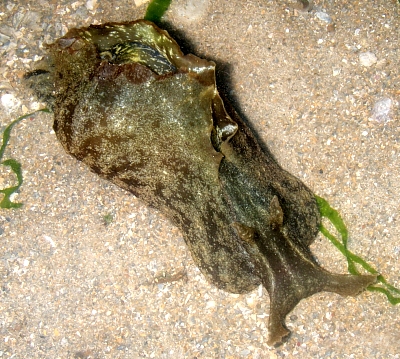Re: Seahare from Singapore
March 29, 2007
From: Ron Yeo

Hi Bill,
I've attached another picture here with a higher resolution. I have received feedback from another visitor from your site that it could be a Syphonota geographica. I'm not sure what is the identifying feature for the S. geographica is though.
Not sure if this helps, but when we placed the sea hare in a tidal pool, it started crawling of the water to the sandy edge, and appear like it was trying to burrow into the sand. But perhaps the sand was too firm, it only managed to get some sand over its body. The body was very smooth though, without any bumps.
Locality: Pulau Sekudu, intertidal, Singapore, South China Sea, 23 March 2007, Intertidal. Length: 100 mm. Photographer: Ron Yeo.
Thanks.
Ron
ronyeo@gmail.com
Yeo, R., 2007 (Mar 29) Re: Seahare from Singapore. [Message in] Sea Slug Forum. Australian Museum, Sydney. Available from http://www.seaslugforum.net/find/19776Dear Ron,
Thanks for this extra photo. It's always helpful to see an animal from different angles. Your anonymous Forum visitor is probably correct in suggesting this is Syphonota geographica, although the rhinophores are quite a bit further forward of the parapodia than I would have expected. It could be the head is stretching out quite a bit in this photo. External characters of Syphonota are quite difficult to define, but the rhinophores are relatively small and usually very near the parapodia, far back on the 'head'. The other general feature is that the body is usually more flattened than most species of Aplysia, and as you will see in other photos on the Forum it usually has a distinctive colour pattern. Interestingly we have a message on the Forum about a more typical looking Syphonota from Singapore [#9109 ], which reports them burrowing in the mud just as you have observed. Some species of Aplysia have also been reported burrowing, so it may just be a coincidence.
I am glad you received feedback from another Forum visitor. I know lots of secondary communication takes place between Forum visitors and participants and I welcome it, because that is part of the function of the Forum. However if any Forum visitor has a good idea, such as that this animal could be Syphonota, please share it wth us all by sending a message to the Forum. I welcome any help available.
Best wishes,
Bill Rudman
Related messages
-
Seahare from Lembeh, Indonesia
From: Zeineb Alhaidari, November 9, 2009 -
Syphonota geographica from South Africa
From: Valda Fraser, June 2, 2008 -
Syphonata geographica eggs
From: Leanne & David Atkinson, February 25, 2008 -
Syphonata geographica mating
From: Leanne & David Atkinson, February 25, 2008 -
Syphonata geographica feeding on Halophila
From: Leanne & David Atkinson, November 27, 2007 -
Syphonota geographica from Bali
From: Teresa (Zubi) Zuberbühler, February 19, 2007 -
Syphonota geographica from northern Bali
From: Danny van Belle, January 31, 2007 -
Syphonota geographica from Dominica
From: Linda Ianniello, July 23, 2004 -
Syphonota geographica from Changi, Singapore
From: Ria Tan, February 5, 2003 -
Re: Syphonota geographica from Italy
From: Erwin Koehler, December 18, 2002 -
Re: Syphonota geographica from Turkey
From: Erwin Koehler, December 13, 2002 -
Syphonota geographica from Turkey
From: Ferda Buyukbaykal , December 12, 2002 -
Syphonota from Sydney
From: Akos Lumnitzer, June 1, 2000 -
Is Syphonota found in Australia or NZ?
From: P.M. Johnson, May 26, 1999
